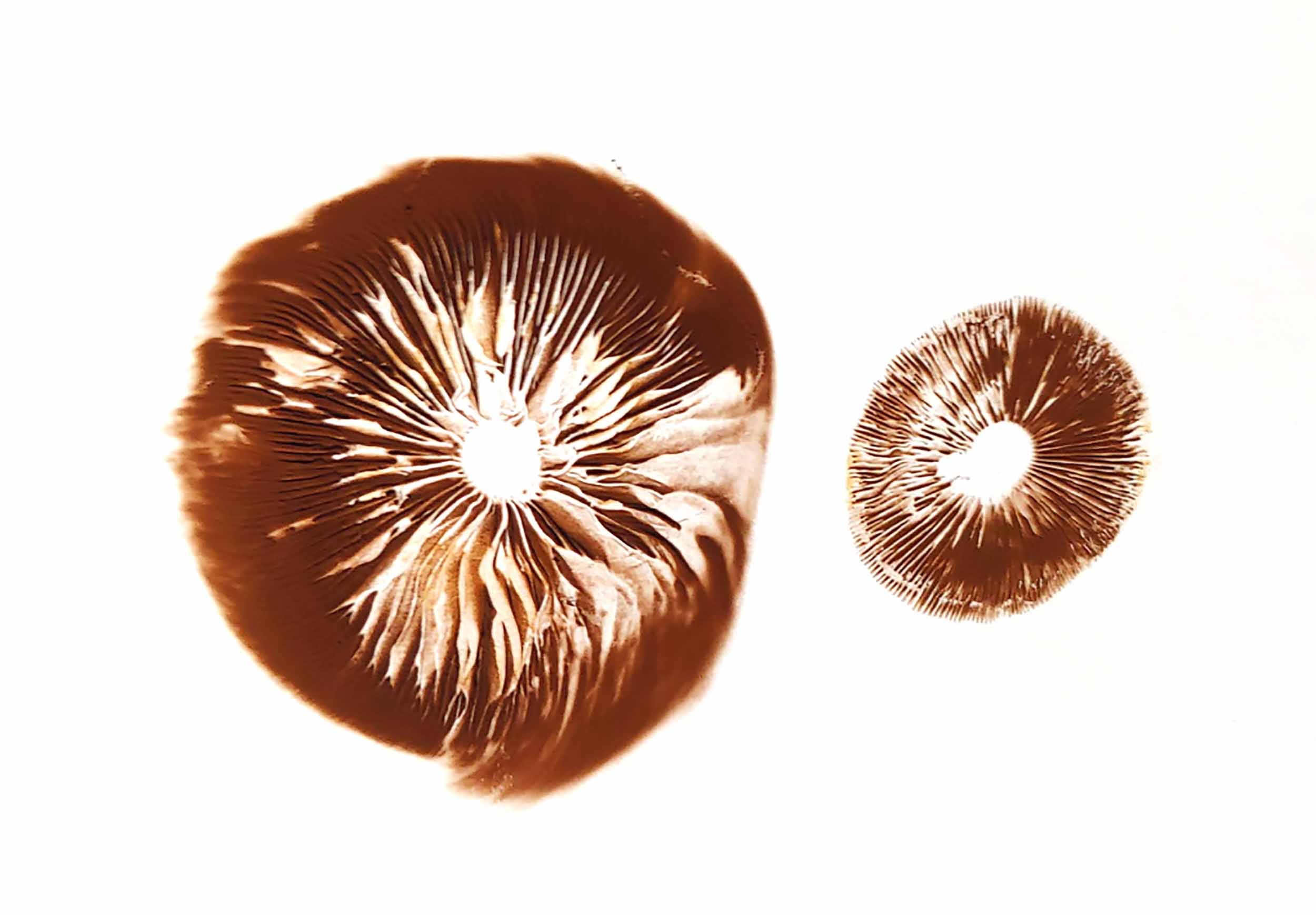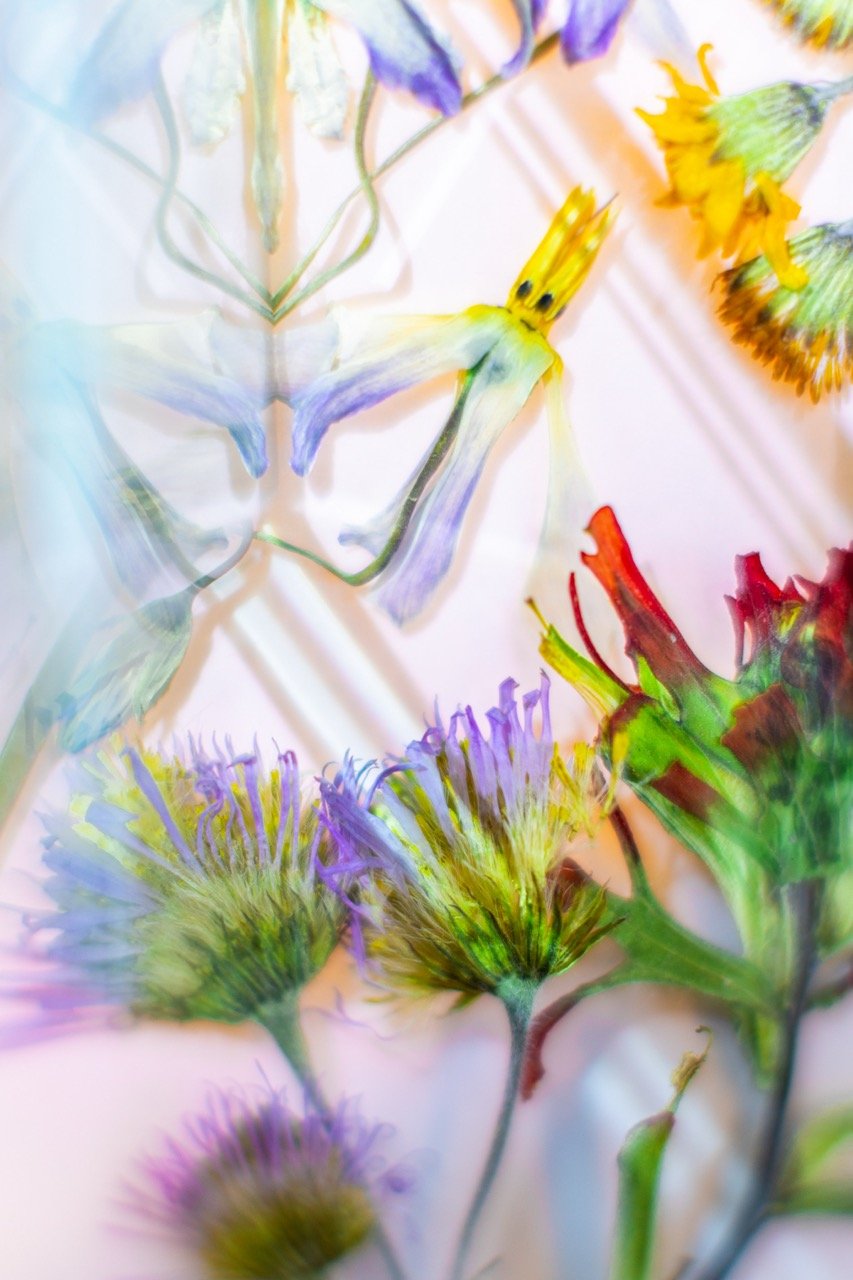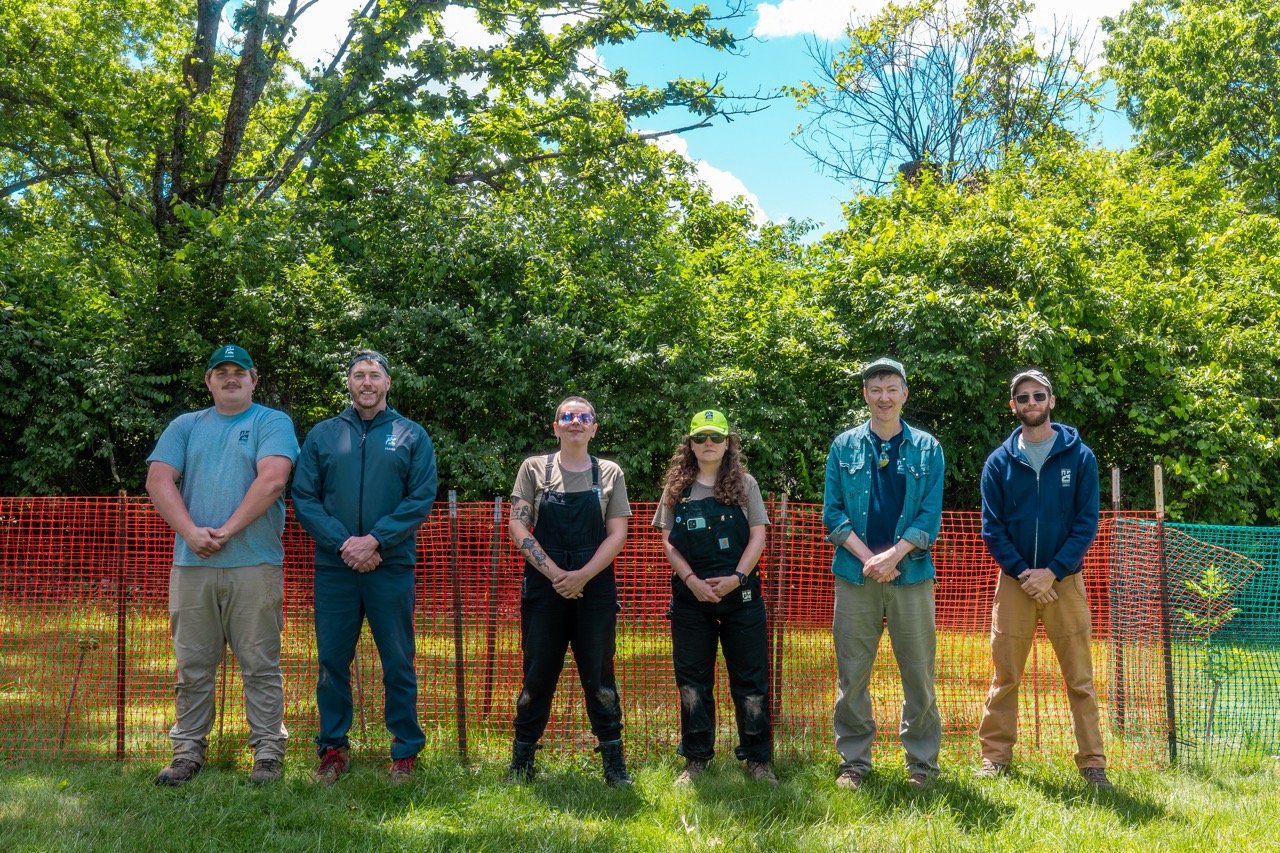Mysterious Mycorrhizae

Get to know the invisible fungi that work wonders to make soil healthy and life-sustaining.
Spore Prints by Maureen Fellinger / Agraria Center for Regenerative Practice
Beneath woods, fields, gardens—wherever plants grow—tiny filaments thread through the soil, seeking their roots. These are mycelia, colonies of fungi called mycorrhizae. You know them by their fruiting bodies: morels, truffles, chanterelles, and more, mushrooms edible and deadly.
While mostly invisible, mycorrhizae are everywhere and they’re essential to life as we know it, through their close symbiosis with close to 90% of terrestrial plants (excluding, for example, many brassicas). The fungi bring nutrients and water to their photosynthetic friends. In return, plants supply mycorrhizae with sugars that, lacking chloroplasts, the fungi can’t make for themselves.
So close knit is this harmonious relationship that many plants rely on mycorrhizae for survival. These arrangements go back at least 450 million years. A prehistoric moss, lacking roots, relied entirely on mycorrhizae. Detailed plant fossils in Devonian chert show mycorrhizae at work.
Geologically speaking, our awareness of mycorrhizae is recent. In the late 19th century, German botanist Albert Bernard Frank coined their name—Latin myco, meaning “of fungus” and Greek rhiza, meaning “root.” Frank suspected the relationship between fungi and roots might be symbiotic, but its positive effects weren’t successfully demonstrated until British researcher Barbara Mosse first successfully cultured them.
Essential to Soil & Plant Life
In recent decades, interest in mycorrhizae has exploded with revelations that they help plants communicate and cooperate. On that fine web of fungal threads, plants can warn one another of pests and even send each other resources.
Xavier University Professor Kathryn Morris studies mycorrhizae’s role in aiding plant communication. “There’s plenty of evidence that young seedlings in a forest canopy actually pull carbon from larger trees around them through the fungal network until they are big enough to access enough light to photosynthesize effectively on their own,” she says.
Those underground threads are actually tiny tubes called hyphae. These are what make up the white gauze you sometimes see surrounding plant roots. Morris also investigates another of mycorrhizae’s incredible qualities, of importance to farmers and gardeners: their ability to transform soil. As they spread, these fungi help form soil aggregates—binding soil particles together so that the mixture becomes more porous and thus more capable of holding water and oxygen. The resulting soil is better at resisting drought and sequestering carbon, properties of vital and timely importance.
Skip the Chemical Treatments
With so many benefits to soil and plants, how can the savvy gardener make their garden friendly to mycorrhizae? Does it help to use soil mixes and additives touting mycorrhizal content?
The good news, if you’re an organic gardener, is that you’re probably doing it already, or, more accurately not doing it. Because when it comes to making your lawn or garden home to beneficial fungi, it’s what you don’t do that counts.
With his British accent, Miami University mycologist and prolific author of books and papers on fungi and the natural world, Professor Nicholas Money doesn’t come off as the boastful type. But he’s proud of his lawn.
“I swear our lawn is prettier than any other lawn in our neighborhood,” he says. “It’s a lot lusher and it seems a lot more drought resistant.”
This, he says, is down to mycorrhizae, which do well in his soil because he hasn’t ever used mineral fertilizers and other chemicals. “We’re the only ones that have never treated our lawn,” he says. “And when we engage in chemical fertilization we’re causing immediate damage to the natural microbial populations in soil. Especially the fungi. They vanish.
“In a suburban garden, there’s a heck of a lot going on,” he continues. “All kinds of invisible activity. And fungi are a huge part of that. So even if we’re not actually seeing the activities of mushrooms directly, they’re there in the soil. They’re interacting with plants. They’re a really important part of that backyard ecosystem.”
The dance between mycorrhizae and plants is dynamic. Plant roots are usually all too happy to share sugars with their mycorrhizal counterparts in exchange for needed nutrients. How close are they? Some mycorrhizae form structures called arbuscules actually inside plant cells, facilitating that exchange. That close.
But if there’s an excess of fertilizer, the relationship falls apart, the connection is lost. As Professor Morris puts it, “If there’s a lot of free fertilizer applied to the soil, then the plant doesn’t need the fungus to take up resources. It will stop supporting the fungi.”
So you want healthy mycorrhizae? Don’t fertilize. Instead, compost.
“Leaf mulch and compost are ideal because they break down slowly,” Professor Morris says. “The resources are released over time rather than all at once.” That slow release keeps beneficial fungi in play, exploring the soil, ready to take advantage of inputs from the compost.
The reason mycorrhizae are great at making nutrients available to plants is because their hyphae are tiny, mere microns in diameter. They can get into spaces on a microscopic level that roots can’t. They vastly extend the surface area available to root systems. Morris says they also seem to be able to free nutrients like phosphorus where it’s bound up in mineral, by dissolving it. But phosphorus uptake is only part of the equation.
“These fungi are beneficial for plants in a whole bunch of ways,” she says. “They increase uptake of water and every nutrient.” The evidence suggests, she adds, “that these fungi and the nitrogen-fixing bacteria that are symbiotic with legumes, peas, and beans play nicely together. They get along well and a healthy plant is more able to support symbiotic nitrogen-fixing bacteria.”
Professor Money further underscores mycorrhizae’s importance to overall biodiversity, including insect populations. They’re central to a panoply of relationships, many of which we’re just beginning to understand.
Leave the Soil Undisturbed
What else should you not do to promote mycorrhizal growth?
First, resist the urge to disturb the soil. “Fungal networks take a long time to grow,” Professor Morris says. “Their hyphae or threads are so small. They’re the diameter of bacteria, so small that we can’t excavate them out of the soil to track where they go.” Disturbance destroys the hyphae, disrupts the network. “Then they have to regrow, reconnect, and explore all the soil volume,” she says. “And that definitely takes time.”
So let that soil be. If possible, leave root structures in place, cutting plants at the soil line rather than yanking them out. This allows fungal material, spores, and decaying plant matter to remain. As the wordsmiths at the White House are fond of saying, to “Build Back Better.”
Given our emerging understanding of mycorrhizae’s benefits, it’s not surprising that the market abounds with mycorrhizal soil mixes and additives. Gardeners and scientists, seeking healthier plants and bigger yields, are experimenting with this fungus. But while adding mycorrhizae to your soil might seem like a good idea, it’s not necessarily the best use of your time and money.
Professor Morris can’t recommend those mycorrhizal soil mixes. When she and her colleagues have checked on the fungus in them, she says, “We haven’t found good viability of any of those inoculants.” The reason for that, she says, “is that these fungi, they’re sensitive. It’s hard to dry them out and package them, leave them on a shelf for six months, and expect them to still be alive. I’m not saying that these companies are intentionally being deceptive—I think they’re trying to package a product that works, but it’s just a difficult product to put together.”
I ask Professor Money about mycorrhizae’s paradoxical fragility and resilience. “Fungal colonies can get quite large,” he says, “and can be damaged in one location, but keep growing in others. And they’ve got this fabulous mechanism of wound repair too, such that they can adapt, they can seal off damage to parts of the colony and then regrow. So I suppose in some sense they are exquisitely sensitive. But they can bounce back swiftly from physical injury, if they’ve been chewed on by a nematode or something.”
So rather than add mycorrhizae in your soil, it might be better to cultivate ideal conditions for colonization. Are there situations, particularly where soil is sterile, where inoculation might help? Yes, and don’t let me stop you. But even then, it’s an issue of potentially putting the cart before the horse. You need to have plants in place for the mycorrhizae to survive. Build your soil and they’ll find it.
Fungus Among Us
Fungal spores are everywhere. They’ve been found at the poles and high in the upper atmosphere. If you are inclined to experiment, check out prolific Alaskan garden writer Jeff Lowenfels’ Teaming with Fungi: the Organic Grower’s Guide to Mycorrhizae, wherein he argues this is an area ripe for citizen science. His book is an excellent primer, chock full of nuggets on growing mycorrhizae and inoculating your soil. The Rodale Institute has conducted its own studies, with positive results, and published methodologies for culturing mycorrhizae and applying them at various scales. But these processes are hundreds of millions of years in the making. It’s OK to get out of the way and let Nature do her thing. The fungi will find their way and, given plants and resources, thrive.
While mycorrhizae mean healthier, more disease- and pest-resistant plants and perhaps even bigger yields, their benefits are greater than that. Much greater. “Fungi are crucial,” Professor Money says. “They are the decomposers in nature. Their activities are pivotal in the carbon cycle. They spin the carbon cycle, circulating elements through the biosphere.”
Mycorrhizal networks have been compared to the internet, popularized as the “wood wide web” by ecologist Dr. Suzanne Simard in her excellent Finding the Mother Tree: Discovering the Wisdom of the Forest. Professor Money feels the analogy doesn’t do justice to the responsiveness and creativity of fungal networks, which are the antithesis of inert machines, far more complicated, and, in my humble opinion, definitely analog. They’re living shapeshifters, beautiful mysteries.
Awareness Breeds Knowledge
“We poison the fungi at our peril,” Professor Money says. “It’s amazing, isn’t it? That we so depend on these organisms and yet most of us are totally unaware of their continuous activities.”
Mycorrhizae have much to teach us. Can we, like them, achieve balance, living as mutualists rather than parasites? Given the gross expense and inefficiency of the chemical fertilization on which our agricultural systems depend, might they hold important answers as global supplies of phosphorus decline and rampant fertilizer runoff causes toxic algae blooms from the Great Lakes to the Gulf?
Fungi have the unusual, magical ability to build and change the world, to alter minds and consciousness itself, albeit in a less groovy, less hallucinatory sense. Because to be aware of mycorrhizae is to see not only the thing itself, to visualize the parts, but to grasp the system. To understand them is to appreciate the complexity at our doorstep, to appreciate the cycle as a whole.
Mycorrhizae have much to teach us yet. But this lesson is clear: To survive and be happy we must tread lightly on this soil.
Plant made possible by fungi: a mycorrhizal “menage a trois.” Although it’s a plant, Indian Pipe (Monotropa uniflora, or Ghost Plant) can’t photosynthesize. Instead, it parasitizes mycorrhizae that are in a symbiotic relationship with another plant. From the plant, through the fungus, Indian Pipe acquires essential sugars. The adaptation allows Indian Pipe to live in deep shade.
Ever since his grandfather put him to work squashing potato bugs and shoveling compost in a vast organic garden north of Philadelphia, Cedric has loved the outdoors. These days, he squashes bugs for his green-thumbed partner, Jen. His writing has appeared in Saveur, Cincinnati, This Old House, and Belt magazines. He is the Collector at the Mercantile Library Downtown.






